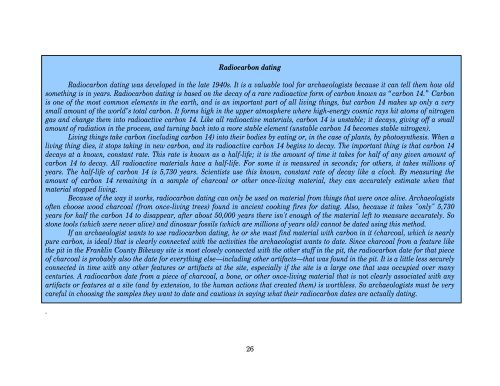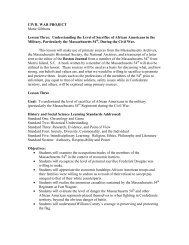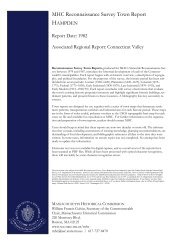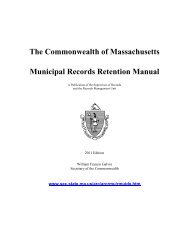Roads, Rails, and Trails - Secretary of the Commonwealth
Roads, Rails, and Trails - Secretary of the Commonwealth
Roads, Rails, and Trails - Secretary of the Commonwealth
You also want an ePaper? Increase the reach of your titles
YUMPU automatically turns print PDFs into web optimized ePapers that Google loves.
Radiocarbon dating<br />
Radiocarbon dating was developed in <strong>the</strong> late 1940s. It is a valuable tool for archaeologists because it can tell <strong>the</strong>m how old<br />
something is in years. Radiocarbon dating is based on <strong>the</strong> decay <strong>of</strong> a rare radioactive form <strong>of</strong> carbon known as “carbon 14.” Carbon<br />
is one <strong>of</strong> <strong>the</strong> most common elements in <strong>the</strong> earth, <strong>and</strong> is an important part <strong>of</strong> all living things, but carbon 14 makes up only a very<br />
small amount <strong>of</strong> <strong>the</strong> world’s total carbon. It forms high in <strong>the</strong> upper atmosphere where high-energy cosmic rays hit atoms <strong>of</strong> nitrogen<br />
gas <strong>and</strong> change <strong>the</strong>m into radioactive carbon 14. Like all radioactive materials, carbon 14 is unstable; it decays, giving <strong>of</strong>f a small<br />
amount <strong>of</strong> radiation in <strong>the</strong> process, <strong>and</strong> turning back into a more stable element (unstable carbon 14 becomes stable nitrogen).<br />
Living things take carbon (including carbon 14) into <strong>the</strong>ir bodies by eating or, in <strong>the</strong> case <strong>of</strong> plants, by photosyn<strong>the</strong>sis. When a<br />
living thing dies, it stops taking in new carbon, <strong>and</strong> its radioactive carbon 14 begins to decay. The important thing is that carbon 14<br />
decays at a known, constant rate. This rate is known as a half-life; it is <strong>the</strong> amount <strong>of</strong> time it takes for half <strong>of</strong> any given amount <strong>of</strong><br />
carbon 14 to decay. All radioactive materials have a half-life. For some it is measured in seconds; for o<strong>the</strong>rs, it takes millions <strong>of</strong><br />
years. The half-life <strong>of</strong> carbon 14 is 5,730 years. Scientists use this known, constant rate <strong>of</strong> decay like a clock. By measuring <strong>the</strong><br />
amount <strong>of</strong> carbon 14 remaining in a sample <strong>of</strong> charcoal or o<strong>the</strong>r once-living material, <strong>the</strong>y can accurately estimate when that<br />
material stopped living.<br />
Because <strong>of</strong> <strong>the</strong> way it works, radiocarbon dating can only be used on material from things that were once alive. Archaeologists<br />
<strong>of</strong>ten choose wood charcoal (from once-living trees) found in ancient cooking fires for dating. Also, because it takes "only" 5,730<br />
years for half <strong>the</strong> carbon 14 to disappear, after about 50,000 years <strong>the</strong>re isn't enough <strong>of</strong> <strong>the</strong> material left to measure accurately. So<br />
stone tools (which were never alive) <strong>and</strong> dinosaur fossils (which are millions <strong>of</strong> years old) cannot be dated using this method.<br />
If an archaeologist wants to use radiocarbon dating, he or she must find material with carbon in it (charcoal, which is nearly<br />
pure carbon, is ideal) that is clearly connected with <strong>the</strong> activities <strong>the</strong> archaeologist wants to date. Since charcoal from a feature like<br />
<strong>the</strong> pit in <strong>the</strong> Franklin County Bikeway site is most closely connected with <strong>the</strong> o<strong>the</strong>r stuff in <strong>the</strong> pit, <strong>the</strong> radiocarbon date for that piece<br />
<strong>of</strong> charcoal is probably also <strong>the</strong> date for everything else—including o<strong>the</strong>r artifacts—that was found in <strong>the</strong> pit. It is a little less securely<br />
connected in time with any o<strong>the</strong>r features or artifacts at <strong>the</strong> site, especially if <strong>the</strong> site is a large one that was occupied over many<br />
centuries. A radiocarbon date from a piece <strong>of</strong> charcoal, a bone, or o<strong>the</strong>r once-living material that is not clearly associated with any<br />
artifacts or features at a site (<strong>and</strong> by extension, to <strong>the</strong> human actions that created <strong>the</strong>m) is worthless. So archaeologists must be very<br />
careful in choosing <strong>the</strong> samples <strong>the</strong>y want to date <strong>and</strong> cautious in saying what <strong>the</strong>ir radiocarbon dates are actually dating.<br />
.<br />
26








